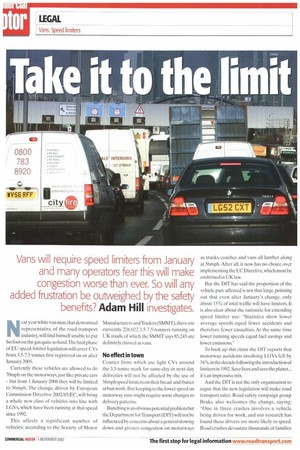Vans will require speed limiters from January
Page 40

Page 41

If you've noticed an error in this article please click here to report it so we can fix it.
and many operators fear this will make congestion worse than ever. So will any added frustration be outweighed by the safety
benefits? Adam Hill investigates.
Next year white van man,that demonised representative of the road transport industry, will find himself unable to put his foot on the gas quite so hard.The final phase of EU speed-limiter legislation will cover CVs from 3.5-7.5 tonnes first registered on or after January 2005.
Currently these vehicles are allowed to do 70mph on the motorways, just like private cars — but from 1 January 2008 they will be limited to 56mph. The change, driven by European Commission Directive 2002/85/EC, will bring a whole new class of vehicles into line with LGVs, which have been running at that speed since 1992.
This affects a significant number of vehicles: according to the Society of Motor Manufacturers and Traders (SMMT),there are currently 226,022 3.5-7.5-tonners running on UK roads of which the SMMT says 85245 are definitely classed as vans.
No effect in town Courier firms which use light CVs around the 3.5-tonne mark for same-day or next-day deliveries will not be affected by the use of 56mph speed limiters on their bread-and-butter urban work. But keeping to the lower speed on motorway runs might require some changes to delivery patterns.
Bunching is an obvious potential problem but the Department forTransport (Dfr) will not he influenced by concerns about a general slowing down and greater congestion on motorways as trucks, coaches and vans all lumber along at 56mph. After all, it now has no choice over implementing the EC Directive, which must be enshrined in UK law.
But the DfT has said the proportion of the vehicle parc affected is not that large, pointing out that even after January's change, only about 15% of total traffic will have limiters It is also clear about the rationale for extending speed limiter use: "Statistics show lower average speeds equal fewer accidents and therefore fewer casualties. At the same time lower running speeds equal fuel savings and lower emissions."
To back up this claim the DfT reports that motorway accidents involving LGVs fell by 34% in the decade following the introduction of limiters in 1992. Save lives and save the planet... it's an impressive mix.
And the DfT is not the only organisation to argue that the new legislation will make road transport safer. Road safety campaign group Brake also welcomes the change, saying: "One in three crashes involves a vehicle being driven for work, and our research has found these drivers are more likely to speed. Road crashes devastate thousands of families every year, and cutting speed saves lives.
Limiting the speed on the vehicles which are most likely to break speed limits on fast roads is essential in cutting the numbers of deaths on our roads."
It seems a compelling argument. But the Freight Transport Association (FA) is not so sure that this particular class of vehicles requires any sort of restraint: "Road safety versus congestion is the top and bottom of it. In terms of vans' ability to overtake there may [now] be a problem. And the other side of it is that the safety record of vans is already very good."
Vans are safest
Indeed it is: taking into account all types of road, LGVs are involved in seven accidents per 100 million vehicle kilometres, a safety record which puts them well ahead of cars (nine accidents) and motorcycles (137 accidents). But the light CVs which will be fitted with speed limiters from January boast an accident rate of just 3.6 on all roads — and this drops to 1.4 on motorways, where the new limiter legislation will have the greatest impact.
"The image of 'white van man' isn't borne out in the accident statistics," the FTA points out. "Any suggestion that these vehicles need restraining is not justified by the figures." So much for current driving habits. But wha about road conditions after 1 January 2008 In terms of congestion things will probabl not be so bad on three-lane motorways, be dual carriageways and two-lane stretches c motorway may present a more frustratin experience for motorists as tens of thousand more vehicles are limited to 56mph.
Only time will tell how many accidents wi be caused by frustrated car drivers taking risk to overtake slower-moving traffic.
"We may also be getting into those categoric of vehicles where operators don't even realis they need limiters," the FTA warns. The issu last year was that operators were having troubl fitting limiters by the due date and that's th warning we should perhaps issue now: th situation is cut and dried and if your vehicl needs retrofitting it is better to do it now tha wait until 31 December." •






















































































































































































